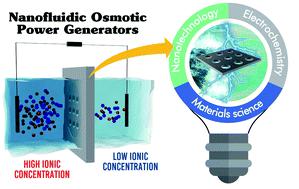当前位置:
X-MOL 学术
›
Chem. Sci.
›
论文详情
Our official English website, www.x-mol.net, welcomes your
feedback! (Note: you will need to create a separate account there.)
Nanofluidic osmotic power generators – advanced nanoporous membranes and nanochannels for blue energy harvesting
Chemical Science ( IF 7.6 ) Pub Date : 2021-09-24 , DOI: 10.1039/d1sc03581a Gregorio Laucirica 1 , María Eugenia Toimil-Molares 2 , Christina Trautmann 2, 3 , Waldemar Marmisollé 1 , Omar Azzaroni 1
Chemical Science ( IF 7.6 ) Pub Date : 2021-09-24 , DOI: 10.1039/d1sc03581a Gregorio Laucirica 1 , María Eugenia Toimil-Molares 2 , Christina Trautmann 2, 3 , Waldemar Marmisollé 1 , Omar Azzaroni 1
Affiliation

|
The increase of energy demand added to the concern for environmental pollution linked to energy generation based on the combustion of fossil fuels has motivated the study and development of new sustainable ways for energy harvesting. Among the different alternatives, the opportunity to generate energy by exploiting the osmotic pressure difference between water sources of different salinities has attracted considerable attention. It is well-known that this objective can be accomplished by employing ion-selective dense membranes. However, so far, the current state of this technology has shown limited performance which hinders its real application. In this context, advanced nanostructured membranes (nanoporous membranes) with high ion flux and selectivity enabling the enhancement of the output power are perceived as a promising strategy to overcome the existing barriers in this technology. While the utilization of nanoporous membranes for osmotic power generation is a relatively new field and therefore, its application for large-scale production is still uncertain, there have been major developments at the laboratory scale in recent years that demonstrate its huge potential. In this review, we introduce a comprehensive analysis of the main fundamental concepts behind osmotic energy generation and how the utilization of nanoporous membranes with tailored ion transport can be a key to the development of high-efficiency blue energy harvesting systems. Also, the document discusses experimental issues related to the different ways to fabricate this new generation of membranes and the different experimental set-ups for the energy-conversion measurements. We highlight the importance of optimizing the experimental variables through the detailed analysis of the influence on the energy capability of geometrical features related to the nanoporous membranes, surface charge density, concentration gradient, temperature, building block integration, and others. Finally, we summarize some representative studies in up-scaled membranes and discuss the main challenges and perspectives of this emerging field.
中文翻译:

纳米流体渗透发电机 – 用于蓝色能量收集的先进纳米多孔膜和纳米通道
能源需求的增加增加了对与基于化石燃料燃烧的能源生产相关的环境污染的担忧,这推动了新的可持续能源收集方式的研究和开发。在不同的替代方案中,通过利用不同盐度水源之间的渗透压差来产生能量的机会引起了相当大的关注。众所周知,这一目标可以通过采用离子选择性致密膜来实现。然而,到目前为止,该技术的现状表现出有限的性能,阻碍了其实际应用。在这种背景下,具有高离子通量和选择性的先进纳米结构膜(纳米孔膜)能够提高输出功率,被认为是克服该技术现有障碍的有前途的策略。虽然利用纳米多孔膜进行渗透发电是一个相对较新的领域,因此其大规模生产的应用仍不确定,但近年来在实验室规模上的重大发展表明了其巨大的潜力。在这篇综述中,我们全面分析了渗透能产生背后的主要基本概念,以及利用具有定制离子传输的纳米多孔膜如何成为开发高效蓝色能量收集系统的关键。此外,该文件还讨论了与制造新一代膜的不同方法以及能量转换测量的不同实验装置相关的实验问题。我们通过详细分析与纳米多孔膜、表面电荷密度、浓度梯度、温度、构建块集成等相关的几何特征对能量能力的影响,强调了优化实验变量的重要性。最后,我们总结了大规模膜方面的一些代表性研究,并讨论了这个新兴领域的主要挑战和前景。
更新日期:2021-09-24
中文翻译:

纳米流体渗透发电机 – 用于蓝色能量收集的先进纳米多孔膜和纳米通道
能源需求的增加增加了对与基于化石燃料燃烧的能源生产相关的环境污染的担忧,这推动了新的可持续能源收集方式的研究和开发。在不同的替代方案中,通过利用不同盐度水源之间的渗透压差来产生能量的机会引起了相当大的关注。众所周知,这一目标可以通过采用离子选择性致密膜来实现。然而,到目前为止,该技术的现状表现出有限的性能,阻碍了其实际应用。在这种背景下,具有高离子通量和选择性的先进纳米结构膜(纳米孔膜)能够提高输出功率,被认为是克服该技术现有障碍的有前途的策略。虽然利用纳米多孔膜进行渗透发电是一个相对较新的领域,因此其大规模生产的应用仍不确定,但近年来在实验室规模上的重大发展表明了其巨大的潜力。在这篇综述中,我们全面分析了渗透能产生背后的主要基本概念,以及利用具有定制离子传输的纳米多孔膜如何成为开发高效蓝色能量收集系统的关键。此外,该文件还讨论了与制造新一代膜的不同方法以及能量转换测量的不同实验装置相关的实验问题。我们通过详细分析与纳米多孔膜、表面电荷密度、浓度梯度、温度、构建块集成等相关的几何特征对能量能力的影响,强调了优化实验变量的重要性。最后,我们总结了大规模膜方面的一些代表性研究,并讨论了这个新兴领域的主要挑战和前景。









































 京公网安备 11010802027423号
京公网安备 11010802027423号